One thing common in the most iconic pop songs is that they are super catchy and easy to remember. However, if you get down to analyzing the chord structure, you’ll find the use of repetitive pop chord progressions to be a common ingredient. Pop songs are also spiced up with hooks designed to grab the listener’s attention.

It all adds up to a memorable and hummable experience. Even those of you who don’t care for pop are sure to have a few “guilty pleasure” pop tunes you secretly love!
If you’re hoping to add crowd-pulling pop bangers to your repertoire, it’s a good idea to learn popular chord sequences used in the genre. We’ll explore 17 of them in this article, but first, let’s look at the most commonly used chords in pop. Once you learn these progressions, head over to our list of fun pop songs to play on guitar, and you’ll notice many of these progressions.
Table of Contents
- List of Pop Chord Progressions
- 1. I – V – vi – IV
- 2. ii – V – I
- 3. I – vi – IV – V
- 4. I – IV – V
- 5. I – V – vi – iii – IV – I – IV – V (Canon in D)
- 6. i – i/7 – IV/b4 – VI (While My Guitar Gently Weeps) Progression
- 7. Andalusian Cadence
- 8. I – bVII – IV
- 9. I – vi – ii – V
- 10. i – bVI – bIII – bVII
- 11. I – IV – vi – V
- 12. vi – IV – I – V
- 13. bVI – bVII – I Cadence
- 14. I – I+- I6 – I7
- 15. IV – I – vi – V
- 16. I – V – I
- 17. I – IV – I
The Four Magic Chords of Pop
There’s a reason that some pop songs sound suspiciously similar. They may differ in lyrical context and stylistic elements, yet they sound pretty close, at least sonically. The reason is four magical chords – I, V, vi, and IV, that have the ability to instantly catch the listener’s attention and hold it through to the end.
Take any major key, like C major. The chords would be C (I), G (V), Am (vi), and F (IV). In the key of G major, these will be G, D, Em, and C. As you’ll find out in this article, the I – V – vi – IV is the most common pop progression, with countless hits built around it. But even with the order changed, these chords still end up creating memorable melodies while sounding characteristically different. The ‘50s chord progression or I – vi – IV – V is a good case in point.
So what’s so special about these chords, and why are the most common pop progressions just different rotations of these chords? Read on to find out.
List of Pop Chord Progressions
1. I – V – vi – IV
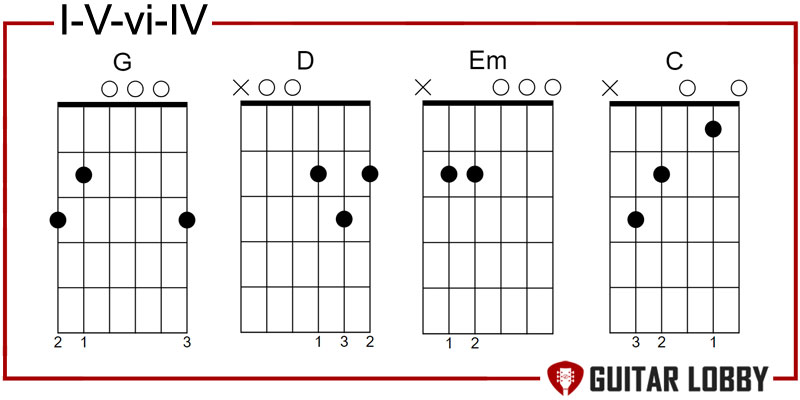
You’re looking at arguably the most popular chord progression in the universe. From the heartbreaking “Someone Like You” by Adele to Lady Gaga’s dance-pop banger “Pokerface,” there are numerous pop tunes that use the 1 – V – vi – IV or 1 – 5 – 6 – 4 progression.
There’s just something about playing these four chords in this order that instantly draws the listener. The movement from the tonic chord (I) to the dominant chord (V) evokes a sense of suspense. The V chord is also where the tension is at its highest, and listeners are already hoping for some kind of release. That’s when we move from the V chord to minor vi, a submediant chord. The task of the submediant chord is to take the tonic to a predominant, which in this case is the IV chord. This is where listeners know they’ll get some resolution, which finally happens when the IV chord returns home to the I or tonic.
In the key of G major, this progression would look like this: G – D – Em – C, where G is the first chord of the major key, D is the V chord, and Em is the minor vi, followed by the C or the IV chord. If you’re already familiar with these chord shapes, play them together, and you’ll find just how familiar the melody sounds.
The timelessness and ubiquity of the 1 – 5 – 6 – 4 was showcased by the Australian comedy act Axis of Awesome in 2011 when they released their famous medley, “Four Chords.” The viral track took listeners through almost 40 classic and modern-day tunes that can be played with these exact chords. Like most chord sequences, the 1 – 5 – 6 – 4 also has a rather interesting minor key version. I’ll be talking about it later in this article.
Popular Songs That Use This Progression: “Let It Be” (The Beatles), “I’m Yours” (Jason Mraz), “Hey Soul Sister” (Train), “Torn” (Natalia Imbruglia), “All of Me” (John Legend).
2. ii – V – I
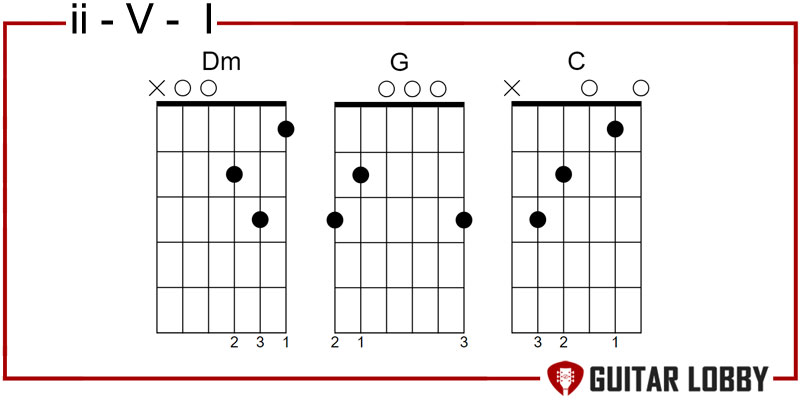
The ii – V – I is extensively used in jazz as a turnaround to bring the listeners back to the tonic (I). So, what’s a popular jazz chord sequence doing in a list of pop chord progressions? Well, it so happens that several pop hits feature this sequence. It’s mainly used as a part of a larger chord progression, like in Eric Clapton’s melancholic ballad “Tears in Heaven.” But you’ll also come across tunes written entirely using the ii – V – I progression, like Maroon 5’s “Sunday Morning.”
The catchy pop melody uses this progression in the key of C major. Here are all the chords you’ll find in that key:
I = C ii = Dm iii = Em IV = F V = G vi = Am vii⁰ = Bdim
We start with the ii chord, which in this case is Dm, followed by the V chord or the G chord, and ending with the I or C chord. When you apply the ii – V – I sequence, you get Dm – G – C. In most cases, you’ll see the 7th chords driving this progression. The use of 7ths would change the chords in our progression to Dm7 – G7 – Cmaj7.
So, what makes this three-chord sequence so special that it dominates an entire genre (jazz) and countless other musical styles, including pop? The 2 – 5 – 1 works because it amps up the tension with the ii chord, making the resolution to the I chord via the V chord more definite.
Popular Songs That Use This Progression: “Boyfriend” (Justin Bieber), “Sunday Morning” (Maroon 5), “Tears in Heaven” (Eric Clapton).
3. I – vi – IV – V
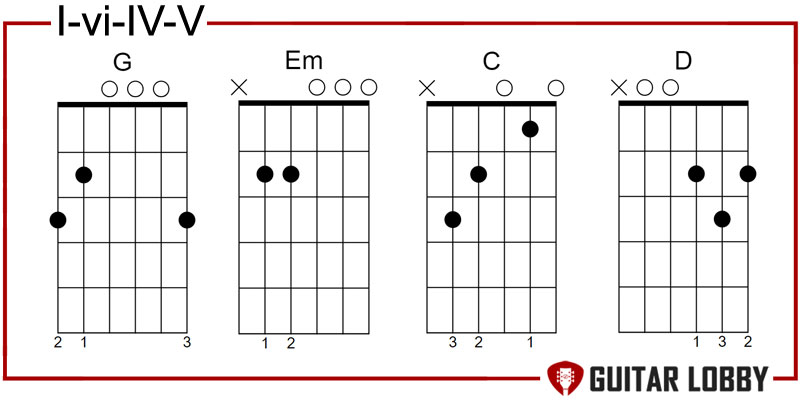
The I – vi – IV – V is also known as the 50’s progression or doo-wop progression because of its prevalence in the ‘50s and early ‘60s. The doo-wop style was a catchy blend of R&B and rock ‘n’ roll, and this progression was at the heart of most doo-wop tunes.
These chords sound so good together that you’ll find them powering a huge chunk of contemporary pop music. Don’t believe me? Check out hits like “Girl on Fire” by Alicia Keys, “Every Breath You Take” by The Police, “Baby” by Justin Bieber,” and “Perfect” by Ed Sheeran for this seriously addictive chord progression. In the key of G major, this progression takes the shape of G – Em – C – D.
The movement from tonic (I) to a tonic substitute (vi), predominant (IV) to dominant (V), is satisfying to listeners. Each chord serves a purpose, starting with the tonic, which passes the baton to the tonic substitute. The tonic substitute or the minor vi chord extends the tonic function while also providing a change in harmony.
The tension picks up with the predominant or IV chord, peaking with the dominant or V chord before resolving to the tonic chord. This motion creates a perfect canvas for creating pop melodies with a bunch of repetitive chords. Just pick these four chords from any scale, and you can write yourself a catchy pop song.
Popular Songs That Use This Progression: “Perfect” (Ed Sheeran), “I’m the One” (DJ Khaled), “Girl on Fire” (Alicia Keys), “Me!” (Taylor Swift), “Dura” (Daddy Yankee).
4. I – IV – V
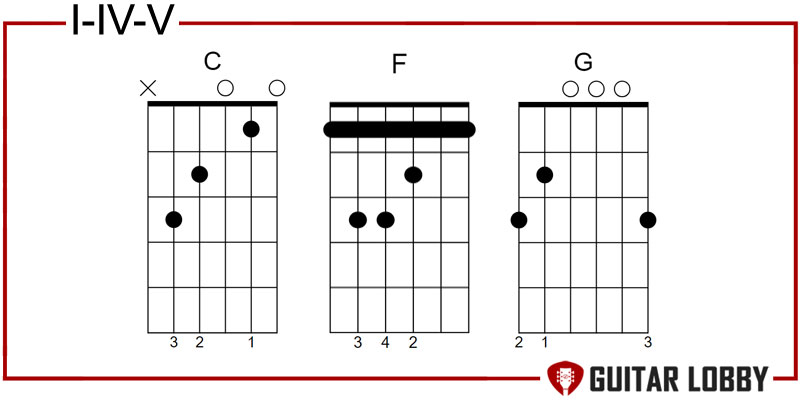
The combination of tonic (I), predominant (IV), and dominant (V) offers endless songwriting possibilities across genres, from blues to pop. You could think of these three chords as building blocks in Western music, each performing a specific function in tonal harmony. The tonic (I) offers resolution, the dominant builds tension, and the predominant acts as a bridge between the two. The three chords, when played in a sequence, make for a satisfying listening experience.
We’ve already seen them used along with other chords in previous examples. But even on their own, the tonic-predominant-dominant and then returning to tonic have powered a lot of pop tunes in the past, like the Latin groove-fest “La Bamba” by Ritchie Valens and Van Morisson’s seminal “Brown Eyed Girl.”
In “La Bamba,” the progression is played throughout the song in the key of C major as C – F – G. As I pointed out earlier, this is a fairly common chord progression but also a pretty flexible one. You can use simple chord substitutions such as suspended chords or dominant 7th chords to make the progression more interesting.
Popular Songs That Use This Progression: “Wild Thing” (The Troggs), “Louie, Louie” (The Kingsmen), “La Bamba” (Ritchie Valens), “Brown Eyed Girl” (Van Morisson), “Thinking of You” (Ed Sheeran).
5. I – V – vi – iii – IV – I – IV – V (Canon in D)
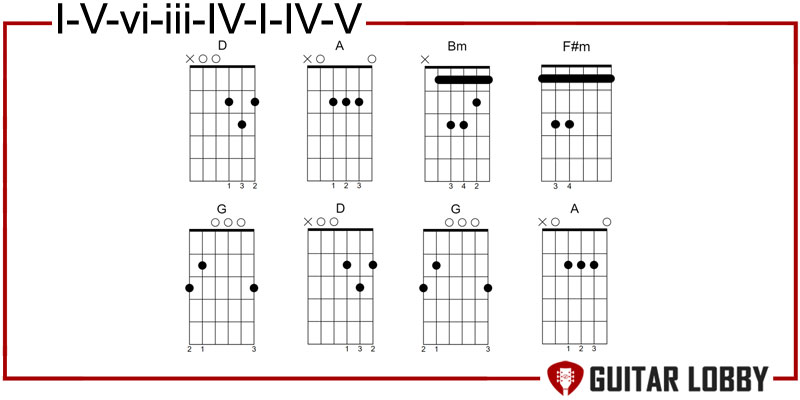
This long-ish progression was composed centuries ago but brought back into the spotlight only after a French conductor, Jean-François Paillard, recorded an arrangement based on it. If we apply the I – V – vi – iii – IV – I – IV – V to the key of D major, it’ll look like D – A – Bm – F#m – G – D – G – A. Note how it touches various chords of the same key before resolving to the tonic. This results in a progression that’s packed with many different flavors and emotions.
The oldest example of this progression, “Canon in D,” was composed by Johann Pachelbel in 1680. The classic piece employs an ostinato and a canon. In other words, you hear the same bassline as well as the same music repeated by three different violins. Since its revival, this sequence has influenced several songwriters and made its way into tons of pop songs, TV commercials, and movie soundtracks. You may not know it by name, but everyone’s heard this progression. Notable examples include “Memories” by Maroon 5 and “Graduation” by Vitamin C.
To me, this chain of chords sounds inspiring and optimistic. And I bet many agree, or why else would “Canon in D” have become a staple at weddings and graduation ceremonies? Like Axis of Awesome’s four-chord medley, a humorous take on the ubiquity of Pachelbel’s sequence can be heard in Rob Paravonian’s “Pachelbel Rant.”
Popular Songs That Use This Progression: “Basket Case” (Green Day), “Firework” (Katy Perry), “Memories” (Maroon 5), “Holding Out for a Hero” (Bonnie Tyler).
6. i – i/7 – IV/b4 – VI (While My Guitar Gently Weeps) Progression
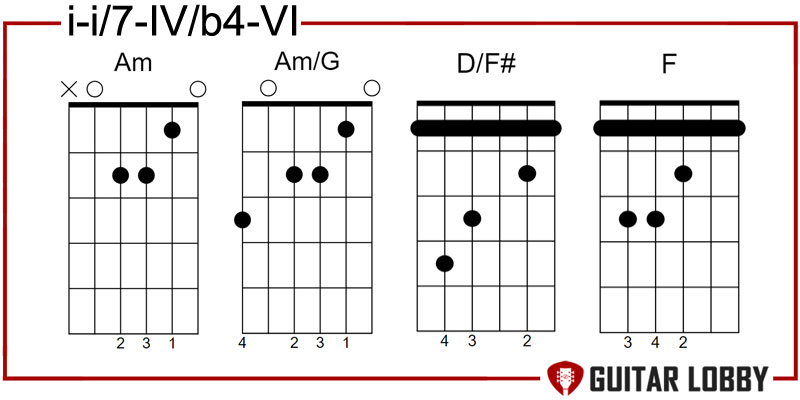
It may not be as popular as some of the other chord sequences on the list, but this ethereal and slightly melancholic progression is used in one of my all-time favorite songs: “While My Guitar Gently Weeps” by the Beatles. Played by George Harrison, this progression is a tricky one to master. And I expect nothing less from the guitar legend.
You could think of it as basic i – i – IV – VI progressions with a descending bassline built into it. Okay, let’s break this down a bit. The i – i – IV – VI progression in A minor would be Am – Am – D – F. But the A minor key is D minor as the iv chord. This simply means that Harrison borrowed the D major chord from another scale. In this case, it was the A melodic minor scale. It made it easier for him to tie in the descending bassline of A – G – F# – F. If we build this bassline to the Am – Am – D – F, we get Am – Am/G – D/F# – F or the same progression that features in the original.
Popular Songs That Use This Progression: “While My Guitar Gently Weeps” by The Beatles.
7. Andalusian Cadence
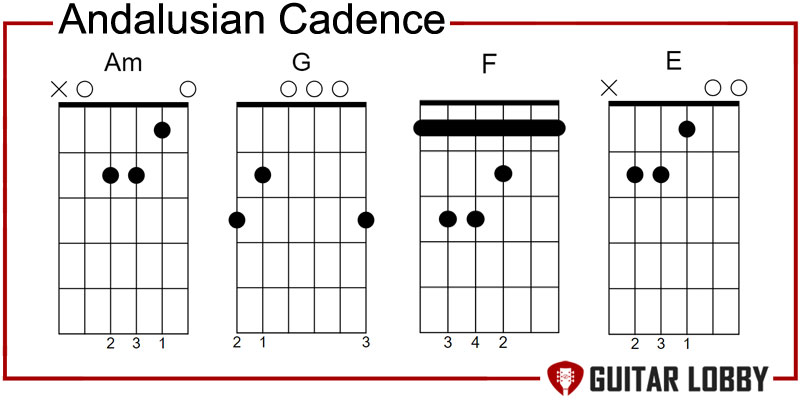
We’ve all heard this progression. So many songs on the pop charts have been built using the Andalusian Cadence. In fact, there’s enough fodder for Axis of Awesome to release another medley based on this chord progression!
In the major key, the Andalusian Cadence looks like vi – V – IV – III. But if you apply it to a minor scale, it becomes i – VII – VI – V. So, in C major, the sequence is Am – G – F – E. If you apply the minor progression to A minor key, you’ll get the same progression Am – G – F – E but with different scale degrees. This progression can also be seen as i – bVII – bVI – V, where ‘b’ represents the root as a whole step below the tonic.
Off the top of my head, there’s “Rolling in the Deep” by Adele, Gotye’s “Somebody That I Used to Know,” and “Smooth Criminal” by Michael Jackson that make excellent use of this cadence. As you may have already guessed from the name, this progression has its roots in Spanish music, more specifically Flamenco. It packs a beautiful walking vibe, which makes it perfect for Flamenco. After all, you’re just walking down the chords of a major scale, stepwise from vi to V to IV to III.
Like other progressions on the list, Andalusian cadence has been adopted in its original form or with variations. One such variation is i – bVII – bVI – bVII, where instead of going to the V chord, you move back to the VII chord. I am sure there are already lots of songs in your repertoire that are based on the Andalusian Cadence and its variations. But I’ve put together a song list below, just in case. This is one of those common pop chord progressions I really recommend you learn.
Popular Songs That Use This Progression: “Genie in a Bottle” (Christina Aguilera), “In the Air Tonight” (Phil Collins), “Rolling in the Deep” (Adele), “Somebody That I Used to Know” (Gotye/Kimra).
8. I – bVII – IV
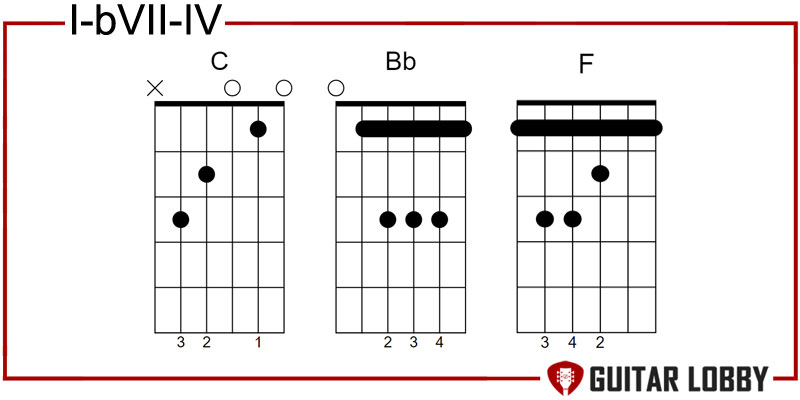
What draws pop musicians to the IV – I movement? It doesn’t give a complete resolution like V – I does, yet the four chords of pop I – V – vi – IV bank on the movement between IV and the tonic. Strangely, most pop musicians are okay with the softer finish. One possible reason could be that many pop songs are circular, and songwriters may not want the strong resolution that comes with the V going back to the I chord.
The movement of the IV chord going to the tonic is also known as the Plagal or Amen cadence. We can see it in action in many of Lorde’s songs. The New Zealand singer-songwriter has a knack for composing songs with fascinating sequences. She uses the I – bVII – IV progression in her hit singles “Solar Power,” “Royals.” and “Green Light.”
As far as the structure goes, this one is basically a less stable version of the circle progression ii – V – I. It resolves but without a V chord, leaving the listeners craving for more. You’ve also got the flattened 7th chord from the Mixolydian mode, giving the sequence a distinctive blues vibe.
For me, the best part about this progression is that you can use it repeatedly without venturing into boring territory. There are plenty of other tracks that make use of this interesting progression, such as those below.
Popular Songs That Use This Progression: “Born This Way” (Lady Gaga), “Solar Power” (Lorde), “Don’t Stop” (Fleetwood Mac).
9. I – vi – ii – V
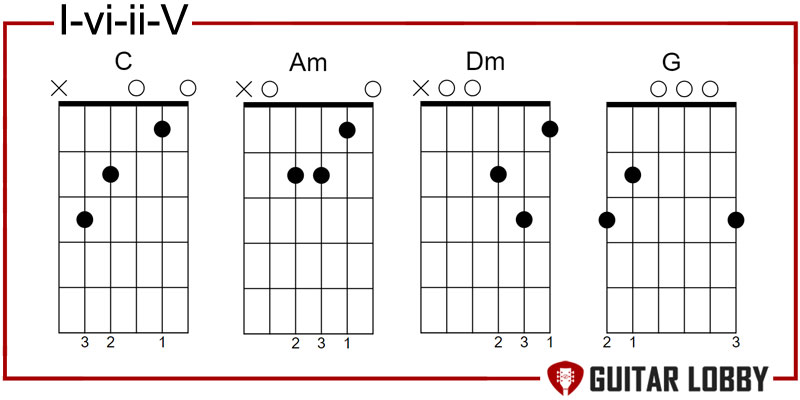
The I – vi – ii – V or 1 – 6 – 2 – 5 is extensively used in jazz and R&B, but there are quite a few pop tracks that employ this progression. Tonally, it offers a great mix of tension and fulfillment. You start with the stable tonic chord, with the vi and the ii chords carrying the sequence forward while lending a mysterious touch. These chords are followed by the tension chord or the Vth chord, which then makes a strong resolution back to the home base.
Besides tonality, the mix of minor and major chords makes this progression well-suited to multiple genres. It’s also so widely used in pop because it’s a variation of the doo-wop progression if you replaced the IV chord with ii. It’s easy to do the substitution because the two chords serve the same function.
In the key of C major, this progression would be C – Am – Dm – G. Meanwhile, in the key of G, you’ll be playing it as G – Em – Am – D. While you’ll find plenty of tunes with this progression in a jazz repertoire, in pop the most notable examples is the use of C – Am – Dm – G in the chorus of Harry Nilsson’s signature tune “Without You.”
Popular Songs That Use This Progression: “Hungry Heart” (Bruce Springsteen), “Have Yourself a Merry Little Christmas” (Judy Garland), “Without You” (Harry Nilsson).
10. i – bVI – bIII – bVII
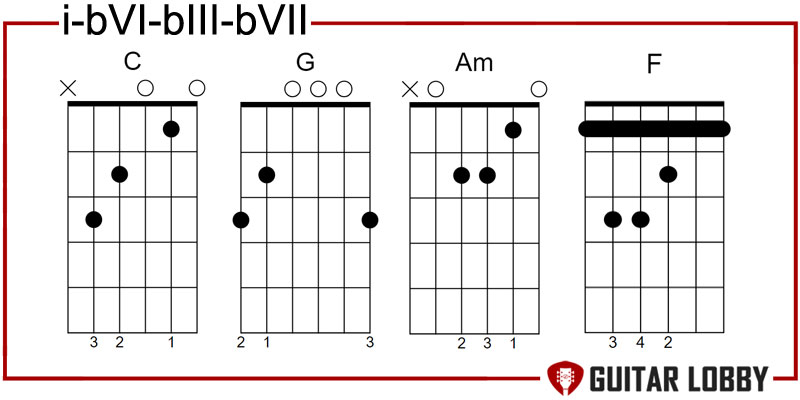
This is one of the most common pop chord progressions involving the i, VI, III, and VII chords of a minor key. In the key of A minor, this progression would move through the chords Am (i), F (bVI), C (bIII), and G (bVII).
One way to look at this progression is as the minor equivalent of I – V – vi – IV, which in the key of C major also has the same chords but in the following sequence: C – G – Am – F. The difference is that in this example, the tonic is A minor instead of C major. Both progressions give you the same chords yet sound starkly different.
The i – bVI – bIII – bVII sounds wistful and moody, often used in a song with a strong lyrical context. In OneRepublic’s mega-hit “Apologize,” this progression can be heard in the key of C minor. Let’s look at the chords in this key:
i = Cm ii° = D° III = Eb iv = Fm v = Gm VI = Ab VII = Bb
This makes the i – bVI – bIII – bVII in C minor look like Cm – Ab – Eb – Bb. In “Apologize,” this progression is played throughout the song. You can also hear it in D minor key as Dm – Bb – F – C in 21 Guns by Green Day and in A minor in Dua Lipa’s “Physical.”
Popular Songs That Use This Progression: “Passenger” (Iggy Pop), “Apologize” (OneRepublic), “21 Guns” (Green Day), “Physical” (Dua Lipa).
11. I – IV – vi – V
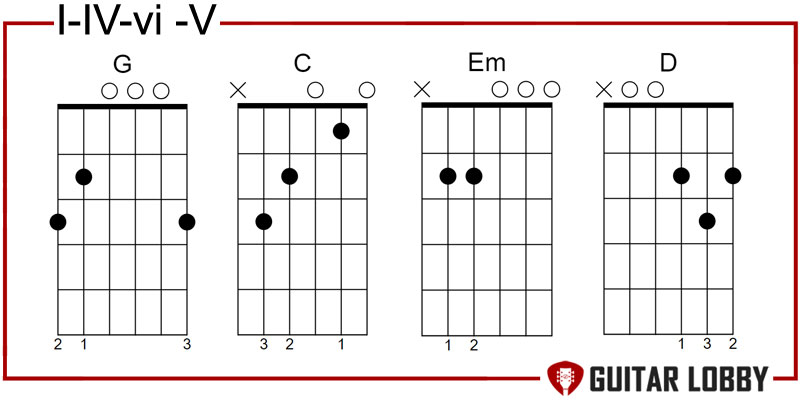
To conjure the sound of the I – IV – vi – V progression, think of “Good Life” by OneRepublic or “You’re the One That I Want” by Olivia Newton-John and John Travolta. If you use this chord sequence in the key of C major, you’ll end up with a C – F – Am – G. Compare this with the doo-wop progression in C, and you’ll notice that the chords are the same except the vi and IV have interchanged places.
This progression works because it leans towards sounding optimistic and energetic. It’s certainly not as somber as the doo-wop progression. To put things in perspective, let’s talk about “Good Life.” The catchy banger about living it up is based on the key of G major and uses this exact progression. The chords you’ll find in the G major key are:
I = G ii = Am iii = Bm IV = C V = D vi = Em vii° = F# dim
Take a look at any tab or tutorial that shows the chords in the song, and you’ll find the G – C – Em – D, powering all parts of the song from the intro to the chorus.
Popular Songs That Use This Progression: “You’re the One That I Want” (Olivia Newton-John and John Travolta), “Good Life” (OneRepublic), “Hit Me With Your Best Shot” (Pat Benatar).
12. vi – IV – I – V
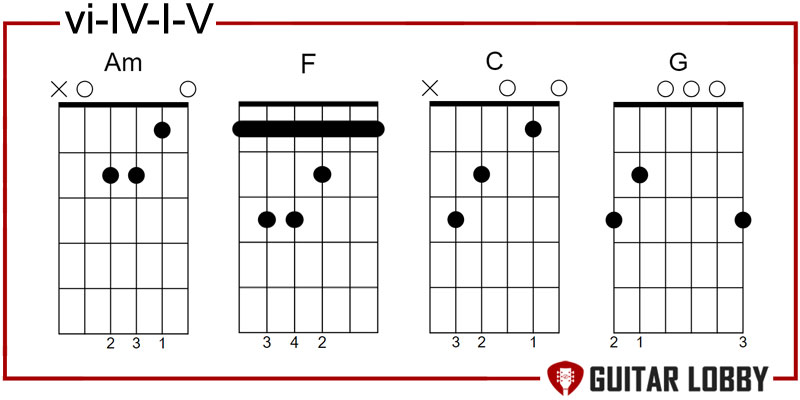
The four magical chords of pop are here again, but this time with a slight twist. The vi – IV – I – V is a variation of the I – V – vi – IV. The twist here is the jumping-off point. Instead of starting with the tonic chord of a major scale, as in the case of the more popular cousin, we start this progression with its sad cousin, the vi chord. In the key of C major, this progression looks like Am – F – C – G.
The origins of this progression can be traced back to the ‘50s, but it snowballed in popularity in the ‘90s and ‘00s pop scene. I say it’s the mix of chords that does the trick, giving this progression the ability to evoke strong emotional reactions. Even though it’s in a major key, it starts on a somber note with a minor vi chord. There is some sense of triumph when the IV moves to the I, but the tension comes right back with the V chord. When played together, this sequence creates a hypnotic effect on the listener.
You may have already heard it in action in “If I Were a Boy” by Beyonce, Toto’s timeless hit “Africa,” and “Stronger (What Doesn’t Kill You)” by Kelly Clarkson. Whether it’s fueling the entire song or just parts of it, it’s safe to say that this is one of the most versatile progressions in pop. From Joan Osborne to Michael Jackson to the Beatles, pop legends with varying styles have generously used this sequence in their songwriting.
Popular Songs That Use This Progression: “Africa” (Toto), “Hello” (Adele), “Girls Like You” (Maroon 5), “Stronger” (Kelly Clarkson).
13. bVI – bVII – I Cadence
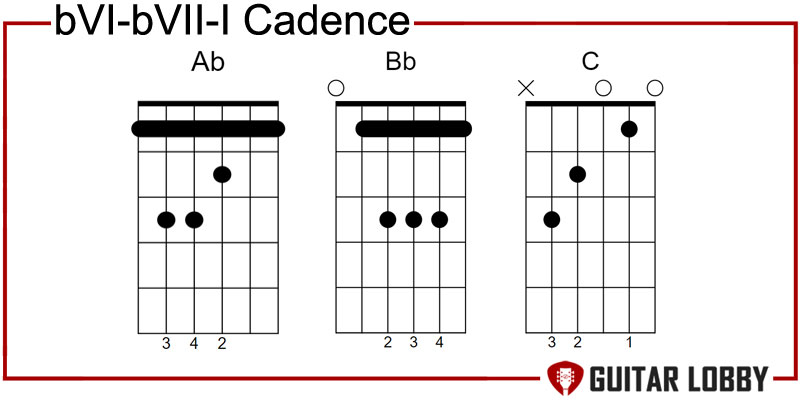
The bVI – bVII – I is a fun cadence to get under your fingers. It’s also called the Mario Cadence, popping up at the end of every level on the Super Mario. It brings a sense of triumph to listeners’ ears. But is it enough to earn a place on a pop chord progression list? Yes, especially since the greatest pop-rock band ever, the Beatles, used it in two of their singles: “With a Little Help from My Friends” and “Lady Madonna.” If you give “With a Little Help from My Friends” a listen, you’ll hear this progression in the song’s opening, in the part where they sing “Billeeee Shears.”
In music theory, a cadence is a chord progression with two or more chords that concludes a musical phrase. Let’s look at this cadence in the key of C major. Since it’s a flat VI – flat VII – I cadence, it’ll have the chords Ab – Bb – C.
Popular Songs That Use This Progression: “I Was Made to Love Her” (Stevie Wonder), “Lady Madonna” (The Beatles), “With a Little Help from My Friends” (The Beatles), Super Mario Theme.
14. I – I+- I6 – I7
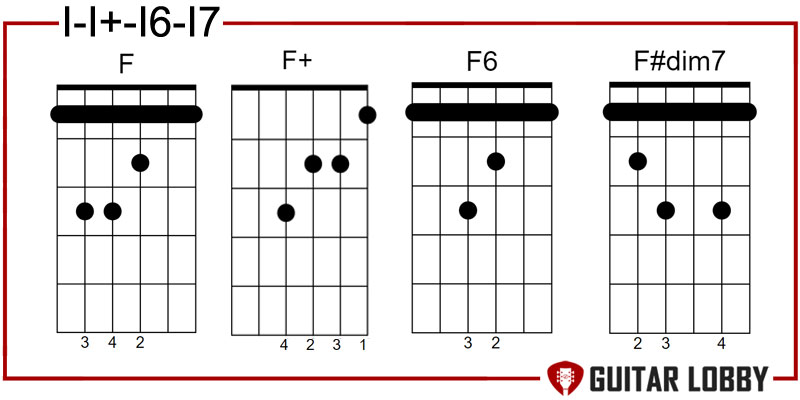
Pop songwriting isn’t always straightforward. It often ventures beyond functional harmony with fascinatingly unique progressions. Take this sequence, for example, the I – I+ – I6 – I7. No matter how strange it looks, there are many heartwarming pop melodies that feature this chain of chords as a part of a larger sequence. Notice how we’re only working with the I or the tonic chord here. But the extensions, I+, I6, and I7, prove highly effective in amping up the tension.
Let’s look at some real-life examples. Stevie Wonder’s “For Once in My Life” is set in the key of F major. If you look at the song’s tabs, you’ll see the sequence F – F+ – F6 – F#dim7 appear in the verses. In the awe-inspiring “Greatest Love of All” by Whitney Houston, this progression shows up with an extra chord as A – A+ – A6 – A9 – A7. Again, even in Houston’s enduring hit, this sequence is part of a larger progression.
Popular Songs That Use This Progression: “Starting Over” (John Lennon), “Greatest Love of All” (Whitney Houston), “Love Will Keep Us Together” (Captain & Tennille), “For Once in My Life” (Stevie Wonder).
15. IV – I – vi – V
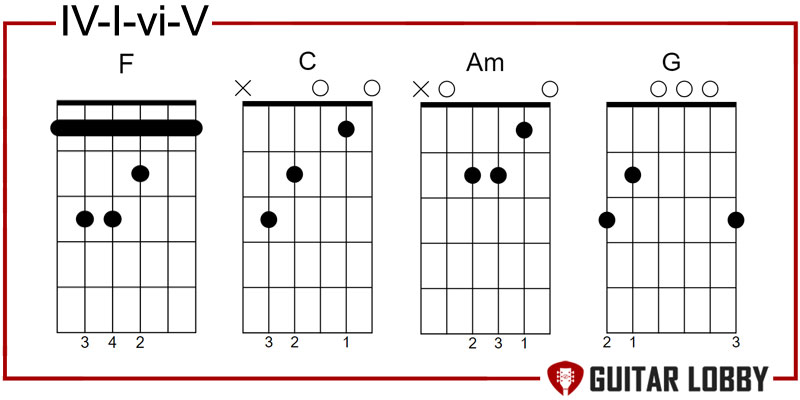
I am not sure if this progression has a name, but I call it the “As Long As You Love Me” sequence since that’s where I heard it first. The progression begins with the IV chord, which usually performs the predominant function, typically preceding the dominant or V chord. However, kicking off the progression with the IV chord lends a mysterious vibe to the tune.
The song is in the key of C major, making the chord sequence F major – C major – A minor – G major. The IV – I – vi – V only shows up in the intro and the chorus of the track. In verses, you’ll hear an entirely different progression that looks like vi – IV – V – I. Note how both progressions use the four most commonly used chords in pop: vi, I, IV, and V, but arranged in a different order to evoke distinct emotions in listeners.
Popular Songs That Use This Progression: “As Long As You Love Me (Backstreet Boys).
16. I – V – I
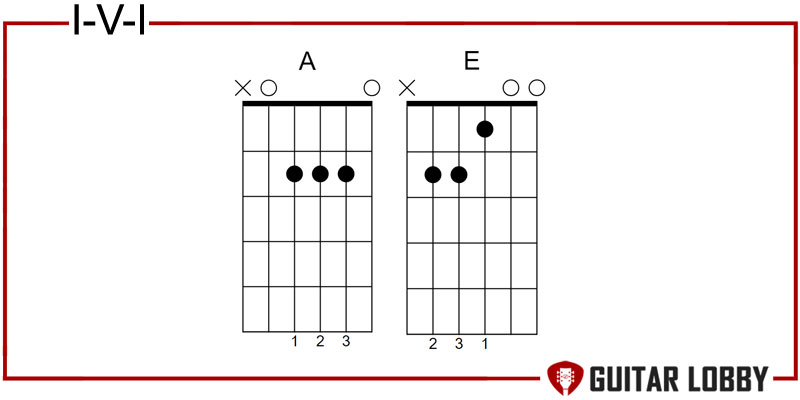
It won’t be fair to wrap up this list without talking about the two simplest pop progressions of all. I am talking about the I – V and I – IV movements. I’ll talk about the alternation between tonic (I) and dominant (V) first, which is found in almost all genres, from reggae to pop.
While the movement from I to V and back to I strikes the perfect balance between tension and resolution, chances are you’ll not find many songs that are entirely based on just two chords from the same scale, except for maybe Billy Ray Cyrus’ country-pop hit “Achy Breaky Heart.” The entire song just banks on A major – E major – A major or I – V – I in the key of A major.
Though two-chord wonders may be few and far between, there are countless examples in pop where these two chords feature prominently. In Bryan Adam’s up-tempo pop rocker “Summer of 69,” this progression goes in the key of D major and is played throughout the verses and the outro in the following order: D major – A major – D major.
Popular Songs That Use This Progression: “Summer of 69” (Bryan Adams), “Achy Breaky Heart” (Billy Ray Cyrus), “A-Yo” (Lady Gaga).
17. I – IV – I
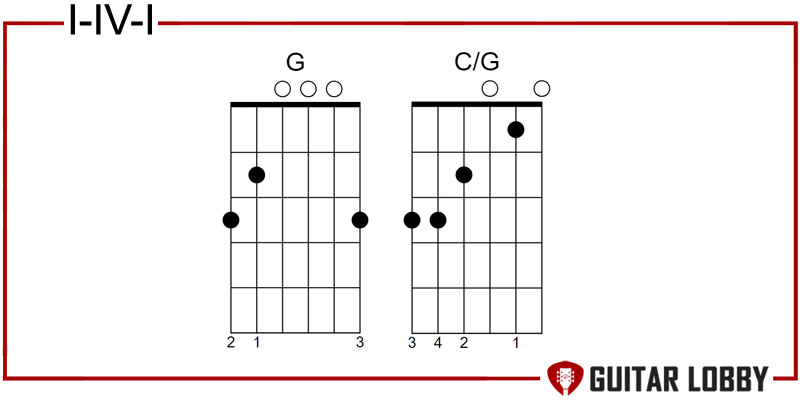
The V – I, along with the IV – I, are the two most powerful cadences to finish a phrase in Western music. While the V – I is called the perfect cadence for offering the strongest finish, the IV – I is called the Plagal cadence for giving a softer conclusion. It has a traditional, hymn-like vibe to it, earning it the name “Amen” cadence.
In pop music, Traffic or Joe Crocker’s version of “Feelin’ Alright” and “I’ll Take You There” by Staple Singers are fundamentally carried by the I – IV – I. “I’ll Take You There” has elements of gospel and soul and managed to crack the top ten in both pop as well as R&B charts back in 1972. It uses the C major key and has the I chord or C major and the IV chord or F major drive the whole tune in a C – F – C sequence.
Another track that comes to mind is the chart-topping single by Sly and the Family Stone’s “Everyday People,” that’s been covered and sampled numerous times. It uses the I – IV – I progression in the G major key but swaps the C major (IV) with a C/G chord for more flavor.
Popular Songs That Use This Progression: “I’ll Take You There” (Staple Singers), “Feelin’ Alright” (Joe Crocker), “Everyday People” (Sly and the Family Stone).
Final Thoughts:
We’ve explored 17 common progressions today, and even if you practice a few, you should be able to broaden your repertoire significantly. If your goal is to impress the crowd, I recommend starting with the four chords of pop in various combinations: I – V – vi – IV, I – IV – V, vi – IV – I – V, and I – vi – IV – V. Once you’ve got a few of these under your belt, you can put your songwriting cap on and create your own melodies. Remember, these progressions are just the building blocks, and writing a memorable song would require you to get creative and bring your style to the equation.

My name is Chris and I’ve had a passion for music and guitars for as long as I can remember. I started this website with some of my friends who are musicians, music teachers, gear heads, and music enthusiasts so we could provide high-quality guitar and music-related content.
I’ve been playing guitar since I was 13 years old and am an avid collector. Amps, pedals, guitars, bass, drums, microphones, studio, and recording gear, I love it all.
I was born and raised in Western Pennsylvania. My background is in Electrical Engineering, earning a Bachelor’s degree from Youngstown State University. With my engineering experience, I’ve developed as a designer of guitar amplifiers and effects. A true passion of mine, I’ve designed, built, and repaired a wide range of guitar amps and electronics. Here at the Guitar Lobby, our aim is to share our passion for Music and gear with the rest of the music community.
